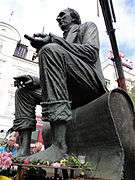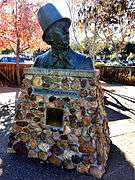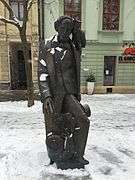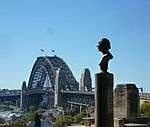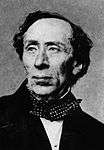Hans Christian Andersen
| Hans Christian Andersen | |
|---|---|
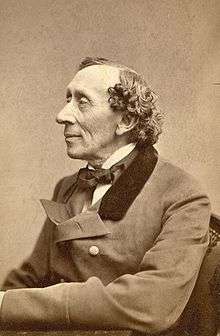 Photograph taken by Thora Hallager, 1869 | |
| Born |
2 April 1805 Odense, Funen, Kingdom of Denmark |
| Died |
4 August 1875 (aged 70) Østerbro, Copenhagen, Kingdom of Denmark |
| Occupation | Writer |
| Language | Danish |
| Nationality | Danish |
| Genre | Children's literature, travelogue |
|
| |
| Signature |
 |
Hans Christian Andersen (/ˈhɑːnz ˈkrɪstʃən ˈændərsən/; Danish: [hanˀs ˈkʰʁæsd̥jan ˈɑnɐsn̩]; often referred to in Scandinavia as H. C. Andersen; 2 April 1805 – 4 August 1875) was a Danish author. Although a prolific writer of plays, travelogues, novels, and poems, Andersen is best remembered for his fairy tales. Andersen's popularity is not limited to children; his stories, called eventyr in Danish, express themes that transcend age and nationality.
Andersen's fairy tales, which have been translated into more than 125 languages,[1] have become culturally embedded in the West's collective consciousness, readily accessible to children, but presenting lessons of virtue and resilience in the face of adversity for mature readers as well.[2] Some of his most famous fairy tales include "The Emperor's New Clothes", "The Little Mermaid", "The Nightingale", "The Snow Queen", "The Ugly Duckling", "Thumbelina", and many more.
His stories have inspired ballets, animated and live-action films, and plays.[3]
Early life
"It doesn't matter about being born in a duckyard, as long as you are hatched from a swan's egg"
Hans Christian Andersen was born in the town of Odense, Denmark, on 2 April 1805. He was an only child. Andersen's father, also Hans, considered himself related to nobility. His paternal grandmother had told his father that their family had in the past belonged to a higher social class,[4] but investigations prove these stories unfounded.[4][5] Theories suggesting that Andersen may have been an illegitimate son of King Christian VIII of Denmark persist.[4]
Andersen's father, who had received an elementary education, introduced Andersen to literature, reading to him Arabian Nights.[6] Andersen's mother, Anne Marie Andersdatter, was uneducated and worked as a washerwoman following his father's death in 1816; she remarried in 1818.[6] Andersen was sent to a local school for poor children where he received a basic education and was forced to support himself, working as an apprentice for a weaver and, later, for a tailor. At 14, he moved to Copenhagen to seek employment as an actor. Having an excellent soprano voice, he was accepted into the Royal Danish Theatre, but his voice soon changed. A colleague at the theatre told him that he considered Andersen a poet. Taking the suggestion seriously, Andersen began to focus on writing.
Jonas Collin, director of the Royal Danish Theatre, felt a great affection for Andersen and sent him to a grammar school in Slagelse, persuading King Frederick VI to pay part of the youth's education.[7] Andersen had already published his first story, "The Ghost at Palnatoke's Grave" (1822). Though not a keen student, he also attended school at Elsinore until 1827.[8]
He later said his years in school were the darkest and most bitter of his life. At one school, he lived at his schoolmaster's home. There he was abused in order "to improve his character", he was told. He later said the faculty had discouraged him from writing in general, causing him to enter a state of depression.
Career
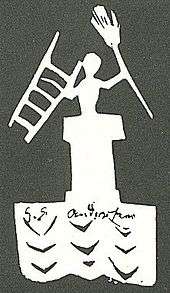
Early work
A very early fairy tale by Andersen, called "The Tallow Candle" (Danish: Tællelyset), was discovered in a Danish archive in October 2012. The story, written in the 1820s, was about a candle who did not feel appreciated. It was written while Andersen was still in school and dedicated to a benefactor, in whose family's possession it remained until it turned up among other family papers in a suitcase in a local archive.[9]
In 1829, Andersen enjoyed considerable success with the short story "A Journey on Foot from Holmen's Canal to the East Point of Amager". Its protagonist meets characters ranging from Saint Peter to a talking cat. Andersen followed this success with a theatrical piece, Love on St. Nicholas Church Tower, and a short volume of poems. Though he made little progress writing and publishing immediately thereafter, in 1833 he received a small traveling grant from the King, enabling him to set out on the first of many journeys through Europe. At Jura, near Le Locle, Switzerland, Andersen wrote the story "Agnete and the Merman". He spent an evening in the Italian seaside village of Sestri Levante the same year, inspiring the name, "The Bay of Fables".[10] In October 1834, he arrived in Rome. Andersen's travels in Italy would be reflected in his first novel, an autobiography titled The Improvisatore (Improvisatoren) which was published in 1835, receiving instant acclaim.
Fairy tales and poetry
His initial attempts at writing fairy tales were revisions of stories that he heard as a child. Andersen then brought this genre to a new level by writing a vast number of fairy tales that were both bold and original. Initially they were not met with recognition, due partly to the difficulty in translating them and capturing his genius for humor and dark pathos.
It was during 1835 that Andersen published the first two installments of his immortal Fairy Tales (Danish: Eventyr; lit. "fantastic tales"). More stories, completing the first volume, were published in 1837. The collection comprises nine tales, including "The Tinderbox", "The Princess and the Pea", "Thumbelina", "The Little Mermaid", and "The Emperor's New Clothes". The quality of these stories was not immediately recognized, and they sold poorly. At the same time, Andersen enjoyed more success with two novels, O.T. (1836) and Only a Fiddler (1837);[11] the latter was reviewed by the young Søren Kierkegaard.
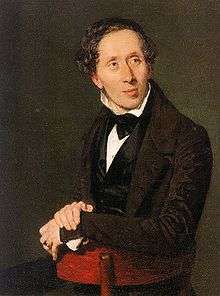
After a visit to Sweden in 1837, Andersen became inspired by Scandinavism and committed himself to writing a poem that would convey the relatedness of Swedes, Danes, and Norwegians.[12] It was in July 1839, during a visit to the island of Funen, that Andersen first wrote the text of his poem, Jeg er en Skandinav ("I am a Scandinavian").[12] Andersen composed the poem to capture "the beauty of the Nordic spirit, the way the three sister nations have gradually grown together", as part of a Scandinavian national anthem.[12] Composer Otto Lindblad set the poem to music, and the composition was published in January 1840. Its popularity peaked in 1845, after which it was seldom sung.[12] Andersen spent two weeks at the Augustenborg Palace in the autumn of 1844.[13]
Andersen returned to the fairy tale genre in 1838 with another collection, Fairy Tales Told for Children. New Collection. First Booklet (Eventyr, fortalte for Børn. Ny Samling), which consists of "The Daisy", "The Steadfast Tin Soldier", and "The Wild Swans".
The year 1845 heralded a breakthrough for Andersen with the publication of four different translations of his fairy tales. "The Little Mermaid" appeared in the periodical Bentley's Miscellany. It was followed by a second volume, Wonderful Stories for Children. Two other volumes enthusiastically received were A Danish Story Book and Danish Fairy Tales and Legends. A review that appeared in the London journal The Athenæum (February 1846) said of Wonderful Stories, "This is a book full of life and fancy; a book for grandfathers no less than grandchildren, not a word of which will be skipped by those who have it once in hand."[2]
Andersen would continue to write fairy tales, and he published them in installments until 1872.
Travelogues
In 1851, he published to wide acclaim In Sweden, a volume of travel sketches. A keen traveler, Andersen published several other long travelogues: Shadow Pictures of a Journey to the Harz, Swiss Saxony, etc. etc. in the Summer of 1831, A Poet's Bazaar, In Spain, and A Visit to Portugal in 1866. (The latter describes his visit with his Portuguese friends Jorge and Jose O'Neill, who were his fellows in the mid-1820s while living in Copenhagen.) In his travelogues, Andersen took heed of some of the contemporary conventions about travel writing, but always developed the genre to suit his own purposes. Each of his travelogues combines documentary and descriptive accounts of the sights he saw with more philosophical passages on topics such as being an author, immortality, and the nature of fiction in the literary travel report. Some of the travelogues, such as In Sweden, even contain fairy-tales.
In the 1840s, Andersen's attention returned to the stage, but with little success. He had better fortune with the publication of the Picture-Book without Pictures (1840). A second series of fairy tales began in 1838 and a third in 1845. Andersen was now celebrated throughout Europe, although his native Denmark still showed some resistance to his pretensions.
Between 1845 and 1864, H. C. Andersen lived at 67 Nyhavn, Copenhagen, where a memorial plaque now stands.[14]
Personal life
Meetings with Dickens
In June 1847, Andersen paid his first visit to England and enjoyed a triumphal social success during the summer. The Countess of Blessington invited him to her parties where intellectual people could meet, and it was at one such party that he met Charles Dickens for the first time. They shook hands and walked to the veranda, about which Andersen wrote in his diary: "We had come to the veranda, I was so happy to see and speak to England's now living writer, whom I love the most."[15]
The two authors respected each other's work and shared something important in common as writers: depictions of the poor and the underclass, who often had difficult lives affected both by the Industrial Revolution and by abject poverty. In the Victorian era there was a growing sympathy for children and an idealization of the innocence of childhood.
Ten years later, Andersen visited England again, primarily to meet Dickens. He extended a brief visit to Dickens' home at Gads Hill Place into a five-week stay, to the distress of Dickens' family. After Andersen was told to leave, Dickens gradually stopped all correspondence between them, to the great disappointment and confusion of Andersen, who had quite enjoyed the visit and never understood why his letters went unanswered.[15]
Love life
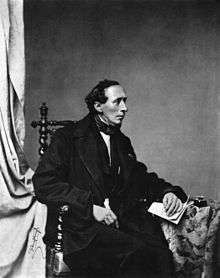
In Andersen's early life, his private journal records his refusal to have sexual relations.[16][17]
Andersen often fell in love with unattainable women, and many of his stories are interpreted as references.[18] At one point, he wrote in his diary: "Almighty God, thee only have I; thou steerest my fate, I must give myself up to thee! Give me a livelihood! Give me a bride! My blood wants love, as my heart does!"[19] A girl named Riborg Voigt was the unrequited love of Andersen's youth. A small pouch containing a long letter from Riborg was found on Andersen's chest when he died, several decades after he first fell in love with her, and after he supposedly fell in love with others. Other disappointments in love included Sophie Ørsted, the daughter of the physicist Hans Christian Ørsted, and Louise Collin, the youngest daughter of his benefactor Jonas Collin. One of his stories, "The Nightingale", was written as an expression of his passion for Jenny Lind and became the inspiration for her nickname, the "Swedish Nightingale". Andersen was often shy around women and had extreme difficulty in proposing to Lind. When Lind was boarding a train to go to an opera concert, Andersen gave Lind a letter of proposal. Her feelings towards him were not the same; she saw him as a brother, writing to him in 1844: "farewell ... God bless and protect my brother is the sincere wish of his affectionate sister, Jenny".[20]
Andersen certainly experienced same-sex love as well: he wrote to Edvard Collin:[21] "I languish for you as for a pretty Calabrian wench ... my sentiments for you are those of a woman. The femininity of my nature and our friendship must remain a mystery."[22] Collin, who preferred women, wrote in his own memoir: "I found myself unable to respond to this love, and this caused the author much suffering." Likewise, the infatuations of the author for the Danish dancer Harald Scharff[23] and Carl Alexander, the young hereditary duke of Saxe-Weimar-Eisenach,[24] did not result in any relationships.
According to Anne Klara Bom and Anya Aarenstrup from the H. C. Andersen Centre of University of Southern Denmark, "To conclude, it is correct to point to the very ambivalent (and also very traumatic) elements in Andersen's emotional life concerning the sexual sphere, but it is decidedly just as wrong to describe him as homosexual and maintain that he had physical relationships with men. He did not. Indeed that would have been entirely contrary to his moral and religious ideas, aspects that are quite outside the field of vision of Wullschlager and her like."[25]
Death
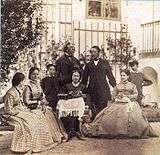
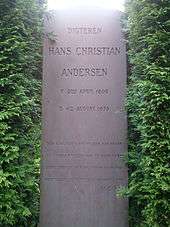
In the spring of 1872, Andersen got off on the wrong side of the bed. He fell out of his bed and was severely hurt; he never recovered. Soon afterward, he started to show signs of liver cancer.[26]
He died on 4 August 1875, in a house called Rolighed (literally: calmness), near Copenhagen, the home of his close friends, the banker Moritz Melchior and his wife.[26] Shortly before his death, Andersen had consulted a composer about the music for his funeral, saying: "Most of the people who will walk after me will be children, so make the beat keep time with little steps."[26] His body was interred in the Assistens Kirkegård in the Nørrebro area of Copenhagen.
At the time of his death, Andersen was internationally revered, and the Danish Government paid him an annual stipend as a "national treasure".[27]
Legacy and cultural influence
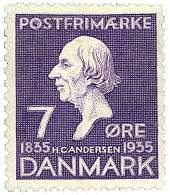

Archives, collections, and museums
- The Hans Christian Andersen Museum in Solvang, California, a city founded by Danes, is devoted to presenting the author's life and works. Displays include models of Andersen's childhood home and of "The Princess and the Pea". The museum also contains hundreds of volumes of Andersen's works, including many illustrated first editions and correspondence with Danish composer Asger Hamerik.[28]
- The Library of Congress Rare Book and Special Collections Division was bequeathed an extensive collection of Andersen materials by the Danish-American actor, Jean Hersholt.[29] Of particular note is an original scrapbook Andersen prepared for the young Jonas Drewsen.[30]
Art, entertainment, and media
Films
- "La petite marchande d'allumettes" (1928; in English: The Little Match Girl), film by Jean Renoir[31] based on "The Little Match Girl"
- Andersen was played by Joachim Gottschalk in the German film The Swedish Nightingale (1941), which portrays his relationship with the singer Jenny Lind.
- Hans Christian Andersen (1952), an American musical film starring Danny Kaye that, though inspired by Andersen's life and literary legacy, was meant to be neither historically nor biographically accurate; it begins by saying, "This is not the story of his life, but a fairy tale about this great spinner of fairy tales"
- The Rankin/Bass Productions-produced fantasy film, The Daydreamer (1966), depicts the young Hans Christian Andersen imaginatively conceiving the stories he would later write.
- The World of Hans Christian Andersen (1968), a Japanese anime fantasy film from Toei Doga, based on the works of Danish author Hans Christian Andersen
- The Little Mermaid, a 1989 animated film based on The Little Mermaid produced by Walt Disney Animation Studios
- Thumbelina, a 1994 animated film based on the "Thumbelina" produced by Warner Bros. Family Entertainment
- One Fantasia 2000 segment is based off The Steadfast Tin Soldier.
- Frozen, a 2013 animated film produced by Walt Disney Animation Studios, was initially intended to be based on The Snow Queen, though numerous changes were made until the end result bore almost no resemblance to the original story.
Literature
Andersen's stories laid the groundwork for other children's classics, such as The Wind in the Willows (1908) by Kenneth Grahame and Winnie-the-Pooh (1926) by A.A. Milne. The technique of making inanimate objects, such as toys, come to life ("Little Ida's Flowers") would later also be used by Lewis Carroll and Beatrix Potter.
- "Match Girl," a short story by Anne Bishop (published in Ruby Slippers, Golden Tears)
- "The Chrysanthemum Robe", a short story by Kara Dalkey (based on "The Emperor's New Clothes" and published in The Armless Maiden)
- The Nightingale by Kara Dalkey, lyrical adult fantasy novel set in the courts of old Japan
- The Girl Who Trod on a Loaf by Kathryn Davis, a contemporary novel about fairy tales and opera
- "Sparks", a short story by Gregory Frost (based on "The Tinder Box", published in Black Swan, White Raven)
- "The Pangs of Love", a short story by Jane Gardam (based on "The Little Mermaid", published in Close Company: Stories of Mothers and Daughters)
- "The Last Poems About the Snow Queen," a poem cycle by Sandra Gilbert (published in Blood Pressure).
- The Snow Queen by Eileen Kernaghan, a gentle Young Adult fantasy novel that brings out the tale's subtle pagan and shamanic elements
- The Wild Swans by Peg Kerr, a novel that brings Andersen's fairy tale to colonial and modern America
- "Steadfast", a short story by Nancy Kress (based on "The Steadfast Tin Soldier", published in Black Swan, White Raven)
- "In the Witch's Garden" (October 2002), a short story by Naomi Kritzer (based on "The Snow Queen", published in Realms of Fantasy magazine)
- Daughter of the Forest by Juliet Marillier, a romantic fantasy novel, set in early Ireland (thematically linked to "The Wild Swans")
- "The Snow Queen", a short story by Patricia A. McKillip (published in Snow White, Blood Red)
- "You, Little Match Girl," a short story by Joyce Carol Oates (published in Black Heart, Ivory Bones)
- "The Real Princess," a short story by Susan Palwick (based on "The Princess and the Pea", published in Ruby Slippers, Golden Tears)
- "The Naked King" ("Голый Король (Goliy Korol)" 1937), "The Shadow" ("Тень (Ten)" 1940), and "The Snow Queen" ("Снежная Королева (Sniezhenaya Koroleva)" 1948) by Eugene Schwartz, reworked and adapted to the contemporary reality plays by one of Russia's playwrights. Schwartz's versions of "The Shadow" and "The Snow Queen" were later made into movies (1971 and 1966, respectively).
- "The Sea Hag," a short story by Melissa Lee Shaw (based on "The Little Mermaid", published in Silver Birch, Blood Moon)
- The Snow Queen by Joan D. Vinge, an award-winning novel that reworks "The Snow Queen"'s themes into epic science fiction
- "The Steadfast Tin Soldier," a short story by Joan D. Vinge (published in Women of Wonder)
- "Swim Thru Fire," a comic by Sophia Foster-Dimino and Annie Mok, based partially off of "The Little Mermaid."
Mobile app
- GivingTales – the storytelling app for children was created in aid of UNICEF in 2015. Hans Christian Andersen's fairy tales are read by Roger Moore, Stephen Fry, Ewan McGregor, Joan Collins and Joanna Lumley.[32]
Monuments and sculptures
|
- Hans Christian Andersen (1880), even before his death, steps had already been taken to erect, in Andersen's honor, a large statue by sculptor August Saabye, which can now be seen in the Rosenborg Castle Gardens in Copenhagen.[3]
- Hans Christian Andersen (1896) by the Danish sculptor Johannes Gelert, at Lincoln Park in Chicago, on Stockton Drive near Webster Avenue[33]
- Hans Christian Andersen (1956), a statue by sculptor Georg J. Lober and designer Otto Frederick Langman, at Central Park Lake in New York City, opposite East 74th Street (40.7744306°N, 73.9677972°W)
Music
- Hans Christian Andersen (album), a 1994 album by Franciscus Henri
- The Song is a Fairytale (Sangen er et Eventyr), a song cycle based on fairy tales by Hans Christian Andersen, composed by Frederik Magle
Stage productions
- Sam the Lovesick Snowman at the Center for Puppetry Arts: a contemporary puppet show by Jon Ludwig inspired by The Snow Man.[34]
- Striking Twelve, a modern musical take on "The Little Match Girl", created and performed by GrooveLily.[35]
- The musical comedy Once Upon a Mattress is based on Andersen' work 'The Princess and the Pea'.
Television
- Hans Christian Andersen: My Life as a Fairytale (2001), a semi-biographical television miniseries that fictionalizes the young life of Danish author Hans Christian Andersen and includes fairytales as short interludes, intertwined into the events of the young author's life
- In the "Metal Fish" episode of the Disney TV series The Little Mermaid, Andersen is a vital character whose inspiration for writing his tale is shown to have been granted by an encounter with the show's protagonists
- The Fairytaler, a 2004 Danish animated television series based on the fairy tales of Hans Christian Andersen.
- Young Andersen, a 2005 biographical television miniseries that tells of the formative boarding school years of fairy tale writer.
Webseries
- Classic Alice (2014), a YouTube webseries, had a five-episode arc based on "The Butterfly"
Awards
- Hans Christian Andersen Awards, prizes awarded annually by the International Board on Books for Young People to an author and illustrator whose complete works have made lasting contributions to children's literature.[36]
- Hans Christian Andersen Literature Award, a Danish literary award established in 2010
Events and holidays
- Andersen's birthday, 2 April, is celebrated as International Children's Book Day.[37]
- The year 2005, designated "Andersen Year" in Denmark,[38] was the bicentenary of Andersen's birth, and his life and work was celebrated around the world.
- In Denmark, a well-attended "once in a lifetime" show was staged in Copenhagen's Parken Stadium during "Andersen Year" to celebrate the writer and his stories.[38]
- The annual H.C. Andersen Marathon, established in 2000, is held in Odense, Denmark
Places named after Andersen
- Hans Christian Andersen Airport, small airport servicing the Danish city of Odense
- Instituto Hans Christian Andersen, Chilean high school located in San Fernando, Colchagua Province, Chile
Postage stamps
- Andersen's legacy includes the postage stamps of Denmark and of Kazakhstan depicted above, depicting Andersen's profile.
Theme parks
- A $13-million theme park based on Andersen's tales and life opened in Shanghai at the end of 2006.[39] Multi-media games and cultural contests related to the fairy tales are available to visitors. Andersen is said to have been celebrated because he was "a nice, hardworking person who was not afraid of poverty".[39]
- The Japanese city of Funabashi also has a children's theme park named after Andersen.[40]
Selected Works
Andersen's fairy tales include:
- The Angel (1843)
- The Bell
- The Emperor's New Clothes (1837)
- The Fir-Tree (1844)
- The Galoshes of Fortune (1838)
- The Happy Family
- The Ice-Maiden (1863)
- It's Quite True!
- Later Tales, published during 1867 & 1868 (1869)
- The Little Match Girl (1845)
- The Little Mermaid (1837)
- Little Tuck
- The Most Incredible Thing (1870)
- The Nightingale (1843)
- The Old House
- The Philosopher's Stone (1859)
- The Princess and the Pea (1835)
- The Red Shoes (1845)
- Sandman (1841)
- The Shadow (1847)
- The Shepherdess and the Chimney Sweep (1845)
- The Snow Queen (1844)
- The Steadfast Tin Soldier (1838)
- The Story of a Mother (1847)
- The Swineherd (1841)
- Thumbelina (1835)
- The Tinderbox (1835)
- The Ugly Duckling (1843)
- The Wild Swans (1838)
See also
- Kjøbenhavnsposten, a Danish newspaper in which Andersen published one of his first poems
- Pleated Christmas hearts, invented by Andersen
- Vilhelm Pedersen, the first illustrator of Andersen's fairy tales
References
- ↑ Wenande, Christian (13 December 2012). "Unknown Hans Christian Andersen fairy tale discovered". The Copenhagen Post. Archived from the original on 14 December 2012. Retrieved 15 December 2012.
- 1 2 Wullschläger 2002
- 1 2 Bredsdorff 1975
- 1 2 3 Rossel 1996, p. 6
- ↑ Askgaard, Ejnar Stig. "The Lineage of Hans Christian Andersen". Odense City Museums. Archived from the original on 4 May 2012.
- 1 2 Rossel 1996, p. 7
- ↑ Hans Christian Andersen - Childhood and Education. Danishnet.
- ↑ "H.C. Andersens skolegang i Helsingør Latinskole". Hcandersen-homepage.dk. Retrieved 2 April 2010.
- ↑ "Local historian finds Hans Christian Andersen's first fairy tale". Politiken.dk. Retrieved 2 June 2013.
- ↑ "Andersen Festival, Sestri Levante". Andersen Festival. Retrieved 2 June 2013.
- ↑ Only a Fiddler from Archive.org
- ↑ Bredsdorff 1975, p. 169
- ↑ "Official Tourism Site of Copenhagen". Visitcopenhagen.com. Retrieved 2 April 2010.
- 1 2 "H.C. Andersen og Charles Dickens 1857". Hcandersen-homepage.dk. Retrieved 16 January 2015.
- ↑ Lepage, Robert (18 January 2006). "Bedtime stories". The Guardian. Retrieved 19 July 2006.
- ↑ Recorded using "special Greek symbols".Garfield, Patricia (21 June 2004). "The Dreams of Hans Christian Andersen" (PDF). p. 29. Retrieved 20 July 2006.
- ↑ Hastings, Waller (4 April 2003). "Hans Christian Andersen". Northern State University. Archived from the original on 23 November 2007. Retrieved 15 December 2012.
- ↑ "The Tales of Hans Christian Andersen". Scandinavian.wisc.edu. Retrieved 2 April 2010.
- ↑ "H.C. Andersen homepage (Danish)". Hcandersen-homepage.dk. Retrieved 2 April 2010.
- ↑ Hans Christian Andersen's correspondence, ed Frederick Crawford6, London. 1891.
- ↑ Seriality and Texts for Young People: The Compulsion to Repeat edited by M. Reimer, N. Ali, D. England, M. Dennis Unrau, Melanie Dennis Unrau
- ↑ de Mylius, Johan. "The Life of Hans Christian Andersen. Day By Day". Hans Christian Andersen Center. Retrieved 22 July 2006.
- ↑ Pritchard, Claudia (27 March 2005). "His dark materials". The Independent. Retrieved 23 July 2006.
- ↑ Hans Christian Andersen Center, Hans Christian Andersen – FAQ
- 1 2 3 Bryant, Mark: Private Lives, 2001, p. 12.
- ↑ http://www.biography.com/people/hans-christian-andersen-9184146#death
- ↑ "The Hans Christian Andersen Museum". SolvangCA.com. Retrieved 16 September 2010.
- ↑ "Jean Hersholt Collections.". Loc.gov. 15 April 2009. Retrieved 2 April 2010.
- ↑ "Billedbog til Jonas Drewsen." (15 April 2009) Retrieved 2 November 2009.
- ↑ La petite marchande d'allumettes (1928) at the Internet Movie Database
- ↑ http://www.imdb.com/title/tt4926058/
- ↑ "The Hans Christian Andersen Statue". Skandinaven. 17 September 1896.
- ↑ "Jon Ludwig's ''Sam the Lovesick Snowman''". Puppet.org. Retrieved 2 April 2010.
- ↑ "Striking 12". GrooveLily. Archived from the original on 6 September 2015.
- ↑ "Hans Christian Andersen Awards". International Board on Books for Young People.
- ↑ "International Children's Book Day". International Board on Books for Young People. Retrieved 17 December 2012.
Since 1967, on or around Hans Christian Andersen's birthday, 2 April, International Children's Book Day (ICBD) is celebrated to inspire a love of reading and to call attention to children's books.
- 1 2 Brabant, Malcolm (1 April 2005). "Enduring legacy of author Andersen". BBC News. BBC. Retrieved 17 December 2012.
- 1 2 China to open Andersen theme park, BBC News, 11 August 2006. Retrieved 2 July 2008.
- ↑ "Chiba Sightseeing Spots". Chiba Prefectional Government. Retrieved 16 June 2011.
Bibliography
- Andersen, Hans Christian (2005) [2004]. Jackie Wullschläger, ed. Fairy Tales. Tiina Nunnally. New York: Viking. ISBN 0-670-03377-4.
- Andersen, Jens (2005) [2003]. Hans Christian Andersen: A New Life. Tiina Nunnally. New York, Woodstock, and London: Overlook Duckworth. ISBN 978-1-58567-737-5.
- Bredsdorff, Elias (1975). Hans Christian Andersen: the story of his life and work 1805–75. Phaidon. ISBN 0-7148-1636-1. Retrieved 4 April 2012.
- Stig Dalager, Journey in Blue, historical, biographical novel about H.C.Andersen, Peter Owen, London 2006, McArthur & Co., Toronto 2006.
- Ruth Manning-Sanders, Swan of Denmark: The Story of Hans Christian Andersen, Heinemann, 1949
- Norton, Rictor (ed.) My Dear Boy: Gay Love Letters through the Centuries. Leyland Publications, San Francisco. 1998 ISBN 0-943595-71-1
- Rossel, Sven Hakon (1996). Hans Christian Andersen: Danish Writer and Citizen of the World. Rodopi. ISBN 90-5183-944-8.
- Stirling, Monica (1965). The Wild Swan: The Life and Times of Hans Christian Andersen. New York: Harcourt, Brace & World, Inc.
- Terry, Walter (1979). The King's Ballet Master. New York: Dodd, Mead & Company. ISBN 0-396-07722-6.
- Wullschläger, Jackie (2002) [2000]. Hans Christian Andersen: The Life of a Storyteller. Chicago: University of Chicago Press. ISBN 0-226-91747-9.
- Zipes, Jack (2005). Hans Christian Andersen: The Misunderstood Storyteller. New York and London: Routledge. ISBN 0-415-97433-X.
External links
- Works by Hans Christian Andersen at Project Gutenberg
- Works by or about Hans Christian Andersen at Internet Archive
- Works by Hans Christian Andersen at LibriVox (public domain audiobooks)

- Works by Hans Christian Andersen at Open Library
- The Story of My Life (1871) by Hans Christian Andersen - English
- Hans Christian Andersen Information Odense
- Hans Christian Andersen biography
- Andersen Fairy Tales
- And the cobbler's son became a princely author Details of Andersen's life and the celebrations.
- The Hans Christian Andersen Center - contains many Andersen's stories in Danish and English
- The Hans Christian Andersen Museum in Odense has a large digital collection of Hans Christian Andersen papercuts, drawings and portraits - You can follow his travels across Europe and explore his Nyhavn study.
- The Orders and Medals Society of Denmark has descriptions of Hans Christian Andersen's Medals and Decorations.
- Jean Hersholt Collections of Hans Christian Andersen From the Rare Book and Special Collections Division at the Library of Congress
- Hans Christian Andersen at the Internet Movie Database

